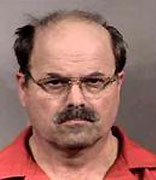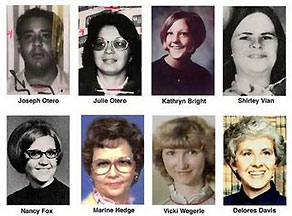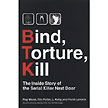
by Jack L. Kennedy--
Kennedy was night police reporter, then education writer, for the Wichita Eagle for nine years before leaving for the Lincoln, NE Journal in October, 1973--three months before BTK began his killing career. One of the street addresses Dennis Rader arbitrarily used in communication with the Eagle later was Old Manor--where one of Kennedy's elderly aunts resided alone for decades.
There was a chill in the air on the January morning in 1974 when Dennis Rader killed four members of the Otero family, two adults and two children, in their modest Wichita home.

Dennis Rader, now 62, shown during booking at the Sedgwick County Jail on February 27, 2005 after a killing spree in Wichita, KS that lasted 17 years.
That chill was to last for 31 years. Rader, or BTK for "bind, torture and kill" as he liked to be known in the media he cultivated, is now in prison serving 10 life sentences for the string of killings through which he terrorized Wichita, Kansas' largest city.
Doors were kept locked; relationships were suspect. Fear ruled. Just when the string seemed to have come to an end, Rader struck again. By the time he was captured and jailed early in 2005 even reporters and cops were sometimes suspects in the midst of the city's three decades of paranoia.
Bind, Torture, Kill--The Inside Story of the Serial Killer Next Door (Harper Collins) is the latest but will not be the last book on Rader, the killings, the times and the fears. It was written by four Eagle staff members who covered the case to some degree: Roy Wenzl, Tim Potter, L. Kelly and Hurst Laviana.
The Eagle has taken some criticism from those who believe the newspaper is living off of the media frenzy and public uneasiness the killer created. Others, however, will read it as a compelling exploration of an evil, complex and confused mind, and the police work that captured him.
There is a self-serving and at times sophomoric pat on the back approach in the newspaper's book-by-committee..which promises more than "just the facts. ma'm," as it childishly steals a line from the old Dragnet show. Less than perfect editing/proofreading leaves some embarassing glitches in spots where they ought not to be.
At times the book seems too close to the police department that finally approved it, after the newspaper initially hid the scope of the fledgling serial killer from the public in the 1970s. The book uses a different approach than that used by Robert Beattie, a lawyer and Wichita State University faculty member who had his own book ready to roll but had to revise it hastily when BTK was captured. But any literary flaws aside (the lead writer could not be reached for rebuttal), this is a book with fascinating pages of history and a glimpse into the makeup of a monster.

Victims of the BTK killer and their dates of death are shown. They include Joseph and Julie Otero and children, Josephine and Joseph (children not shown), January 15, 1974; Kathryn Bright, April 4, 1974; Shirley Vian, March 17, 1977; Nancy Fox, December 8, 1977; Marine Hedge, April 27, 1985; Vicki Wegerle, September 16, 1986; and Dolores E. Davies, January 18, 1991.
It is hard to divorce news media from the crime spree--not the hoardes who descended upon Wichita when Rader was captured, but the home-town journalists who had to weigh the latest letter or other odd communication they got from Rader. Indeed, it was his ego and love of limelight that captured him after 31 years.
One of those journalists, whom the Eagle-written book recognizes often, is Ron Loewen, a 20-something cameraman, then anchor, then news director at KAKE-TV. At one time, Loewen and other staffers there were placed under police protection. He and his colleagues got some of the early, puzzling communications from Rader. They had to determine how to handle them, and had a run-in or two with police who wanted to silence them, or at least mute their voice for a time. What does Loewen, as a former Wichita Eagle writer himself, think of the book?
Loewen, a media consultant, now whom observers tabbed from day one in his career as a bright, perceptive, multi-talented person, said in an e-mail interview that "the police-approved Eagle book offered a welcome, if somewhat unsatisfying insight into the sleuthing that led to the capture. It offers a treasure trove of information, but lacks the grit and insight" that a book by one author alone not tied to the police perspective could have had. The police often erred, Loewen said, and the Eagle was too eager to go along with their wishes.
Larry Hatteberg, a contemporary of Loewen's and longtime KAKE-TV anchor who still can be seen on Channel 22 locally via Cox Cable, interviewed Rader in prison at El Dorado, KS. In one of the book's memorable closing chapters, Rader, the one-time Park City animal control officer, WSU criminal justice student, church president and keeper of trophies from his victims, told Hatteberg that he was driven from within by "Factor X" to do what he did, again and again.
"The real question that no one has yet answered is 'why?," Hatteberg said via e-mail. "What made Dennis Rader turn into the monster that he became? Until society figures that out, the case is not yet solved."
The book by committee does recognize in hindsight that the newspaper itself might have been too cooperative with cops in the early days; it also cites the role of KAKE and the alternative Wichita Sun. Many people, perhaps, should have been fleshed out more as characters, but its focus on Rader on one side and police team leader Ken Landwehr on the other is a clean literary device. There were many important police actors in the drama during its lifetime. One, a scrappy beat cop named Richard LaMunyon, became chief of police and retired before it was all over. (For CSI fans, or bad guys who think of the region as backwoods, a lesson: Wichita under legendary police chief Orlando Wilson had the first mobile crime scene lab in the 1930s before he reformed Chicago's force. The PD had a tradition for innovation that Rader perhaps did not realize would help catch him, right down to DNA evidence.)
Rader, the youth leader who left a Boy Scout camp at night to commit one of the murders, was the closest thing he had ever seen to "a man without a soul," Detective Clint Snyder said after the capture. Rader said he was unhappy, unfulfilled after he saw a 2004 Eagle story on the anniversary of his first horrific act some 30 years earlier. He thought he had not gotten enough attention.
The still-grieving families of his victims would not agree.

Title - Bind, Torture, Kill--The Inside Story of the Serial Killer Next Door
Authors - Roy Wenzl, Tim Potter, L. Kelly and Hurst Laviana
Publisher - William Morrow, Div. of Harper Collins; first edition (06/07)/342 pp./$25.95 list (available at amazon.com)/
ISBN-10: 0061246506 and ISBN-13: 978-0061246500






Comments